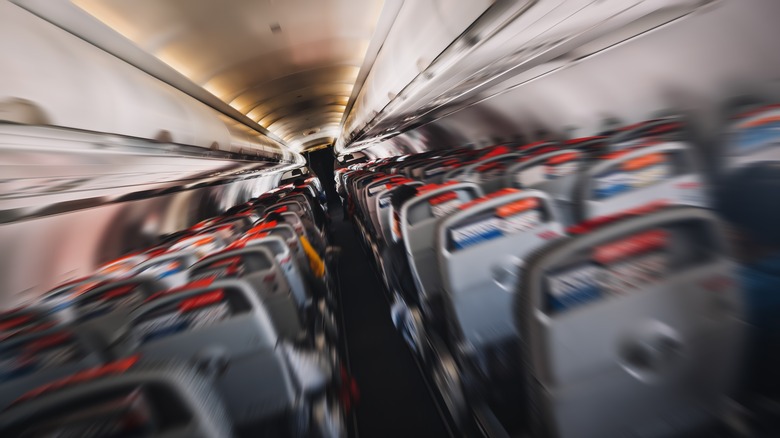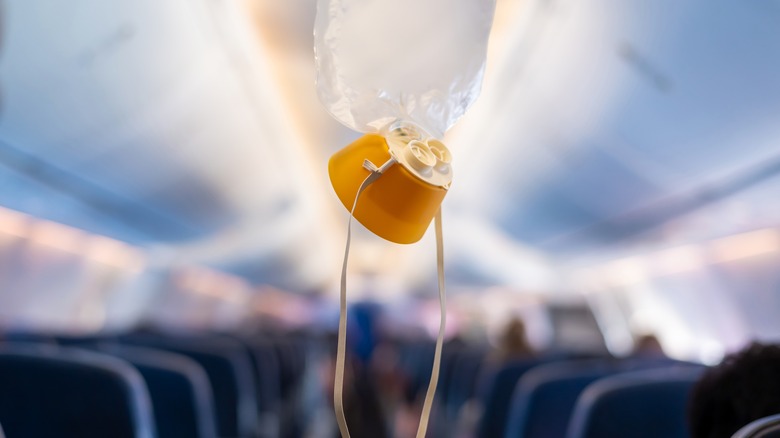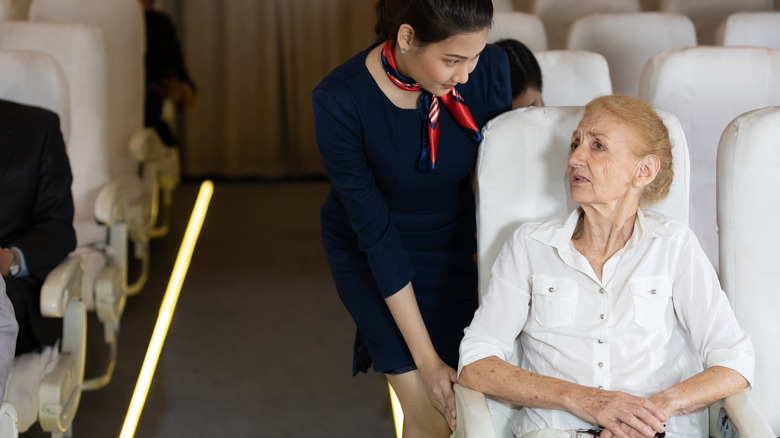A Veteran Flight Attendant Shares Signs That Could Mean Trouble On An Airplane
Flying can be an anxiety-inducing experience for many passengers — The Hill reported that 40% of Americans experience aviophobia to some degree — with every noise and movement raising concerns about the safety of the flight. To shed light on what could signify a real issue versus a routine occurrence, we spoke with Barbi, a journalist and veteran flight attendant with nearly 40 years of flying experience with a major U.S. carrier. Here are her insights on the subtle and not-so-subtle signs that might indicate trouble on an airplane.
According to Barbi, flight attendants are trained to maintain a calm and composed demeanor, even in the face of serious issues. "Crews do their best not to give away any indication that there is a serious issue during a flight until we are ready to share it with the passengers," she explains. As you might imagine, the primary goal is to prevent unnecessary public panic and manage the situation effectively. If a plane is about to crash, pilots display the same professionalism.
However, a few behaviors might hint at something unusual. If you notice flight attendants moving quickly and purposefully to a specific area of the plane or if the crew clearly deviates from regular service without any explanation, it could indicate that they are addressing a non-routine issue. In the case of a medical emergency on your flight — unless it's someone you know or you are a doctor — crew and other medical professionals aboard the plane will take care of the passenger.
Rapid decompression, changes in altitude, and noises
Despite these indicators, Barbi reassures passengers that they will be informed if necessary: "If there is a serious situation on a flight, passengers will be notified. The only time passengers wouldn't be told of such a situation is if it happens so fast that the crew and passengers are finding out at the same time, such as a door blowing open." Different types of aircraft and emergencies present their own unique challenges, but Barbi did provide some general signs to be aware of. One of the rare but critical emergencies is rapid decompression, where a significant breach in the fuselage causes the cabin pressure to drop suddenly. When this happens, it will be no secret to anyone on the plane.
Barbi describes this scenario: "Rapid decompressions will have loud or booming sounds, a whoosh of air will fill the cabin, debris will fly about the cabin and oxygen masks will drop if you are on a commercial jet with capabilities to fly at high altitudes." The cabin will also get foggy as temperatures plummet — however, rapid decompression is extreme, and we repeat, rare. Another sign to beware is significant and sudden changes in altitude. This indicates that pilots are avoiding a problem, such as severe turbulence. If an aircraft makes any new, unusual, or particularly loud noises — outside of the regular hum and drum — that can also be a concern. Check out our guide on different airplane noises and what they mean.
What to do if you suspect a problem
If you think there might be an issue, Barbi's advice is straightforward: "If you see something, say something." Reporting your concerns allows the crew to assess the situation. "It may be nothing, but by bringing it to the attention of crew, they can discern if it warrants emergency procedures." If you notice flight attendants behaving unusually or deviating from normal service, stay in your seat and wait for further instructions. Crew are trained to manage emergencies and will communicate if any passenger assistance is needed.
Barbi notes that sometimes passengers misinterpret routine events as serious issues, including everyone's favorite — turbulence. Jolting and shaking during turbulence can be alarming but are generally not dangerous. Pilots, crew, and aircraft are well-equipped to handle it. Also, seeing a flight attendant rush down the aisle doesn't necessarily indicate an emergency. It could very well be something mundane, like retrieving extra supplies for food service.
For final advice, Barbi assures that if the crew appears calm and continues their duties, there's likely no issue. Always keep your seatbelt fastened when seated to avoid injury during unexpected turbulence. Finally, "If you are sick, do not fly. The last thing you need to do is be 35,000 feet above the ground, stuck in a metal tube with no way to get to a hospital if things get worse." By understanding these signs and following these tips, passengers can feel more secure and better prepared to handle their next flight.


